Crispy Pork Noodles (脆哨面)
A spicy noodle classic to Bijie, Guizhou - (ever so slightly) reimagined
The above are crispy pork noodles, from the Guizhou province. At some level, I probably don’t need to elaborate any further here: if you like spicy noodles, and if you like crispy pork, jump to the recipe below. It’s not difficult, and can be whipped up pretty quick.
The dish originally hails from the city of Bijie, a town about a two hour drive west into the hills from the provincial capital of Guiyang. The city is very… Guizhou. It’s surprisingly dense for a city its size, as the mountainous terrain forced people to build upwards. It’s got a certain sort of charming grit to it — I mean, where else would the street grilled potato stands have little cup-holders for your baijiu liquor? There’s a lively open air market right at the city center, people cap off their nights with booze-soaked grill pots, and of course… the food is absolutely fantastic.



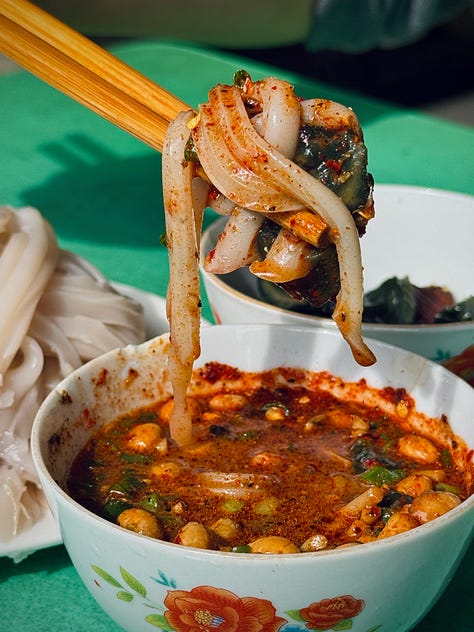


And like much of Guizhou, ubiquitous to the food scene is an ingredient called cuishao (脆哨) — Guizhou crispy pork (above, bottom right). Walk the streets of a Guizhou city, and at any given time you’re probably not overly far from a cuishao shop: the ingredient is featured everywhere from the province’s ‘freestyle’ fried rice, to homestyle cuishao fried fermented soybean, to their ever-ubiquitous breakfast sticky rice.
But this dish? This dish is… a little different than the ones above. And that’s because at its heart this noodle is an answer to a problem — a problem core to the nature cuishao production.
How Cuishao is Manufactured
We’ve covered how to make cuishao before, but it should be noted that said video was sort of a home-cooking ‘hack’ compared to the somewhat more laborious approach employed by workshops. Here is a very good video showing the stages of actual cuishao manufacturing. I’m going to be grabbing screenshots from said video to help illustrate this next bit, but if you know a bit of Chinese the whole thing is heavily recommended.
First, Cuishao starts from large wok filled to the brim with pork fat. This is then heated over a high flame, while stirring constantly — the workshop above has a machine that does its stirring, which is very cool.
After a while, the fat will begin to get golden brown. It’s at this point that you will want to remove much of the rendered oil from the enterprise, as this stuff is good to use as lard. It can be used for other purposes, or sold at the market, or sold off to restaurants.
Then, liquid seasoning is added — in addition to water, this will contain salt, dark soy sauce, dark Chinese vinegar, baijiu liquor, and spices… together with some sort of sweet component (generally Laozao sweet fermented rice, jaggery, honey, or a combination thereof). This is then cooked down over a lower flame — stirring aggressively — until the liquid evaporates away, leaving just the oil and the fried pork bits.

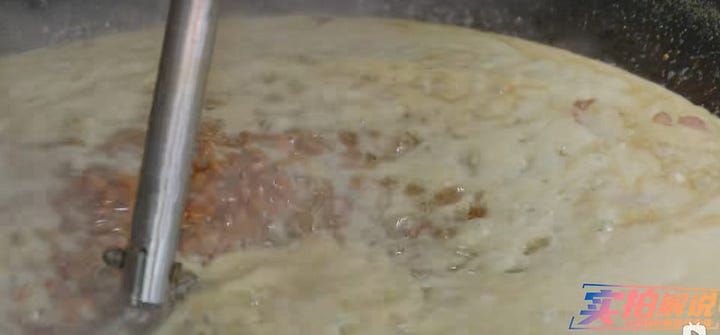
This stage is crucial – a splash of the previously fried out lard is added to the wok in order to lower the oil temperature, and the cuishao is then fried until crunchy. The cuishao is then jiggled in a spider to remove any uneven seasoning, before we get the final result.



But then, a problem. The ‘clean’ lard that was rendered off before can be repurposed and/or sold off. But what about this stuff? It’s murky from frying, and extremely porky. You certainly wouldn’t want to use it to laminate your flaky Baozi.
The answer? Noodles.
Whip up a bowl of spicy noodles with some of the Southwest China usual suspects, splash some of the oil over a heap of fragrant chili powder. Excess lard re-used (in delicious fashion), problem solved.

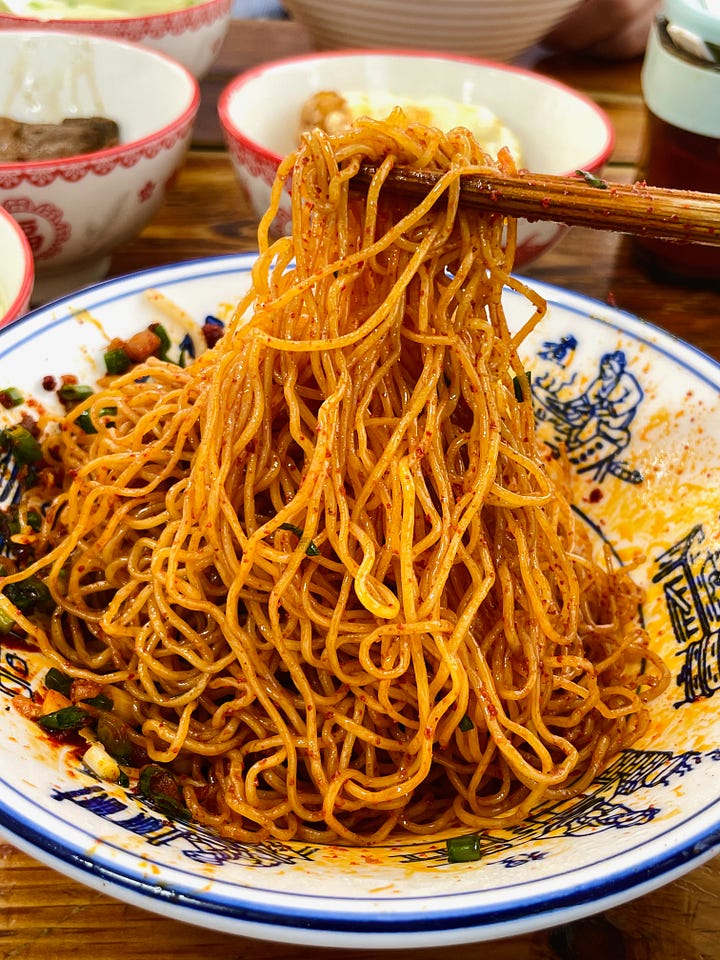
Recreating at Home
So. Three core considerations for recreating this dish in an international home kitchen: (1) cuishao, the crispy pork (2) the noodles and (3) the chili.
Crispy Pork
Originally, at their core, Bijie Cuishao Noodles were a by-product of cuishao production. As such, if the noodles themselves are our expressed goal, I don’t think it makes much sense to go through the whole enterprise of Cuishao production. Even using our previous home-kitchen approach, the thing is… a project. Quantity helps, experience helps, here all we’re really aiming for is… some spicy noodles with crispy pork.
So instead, we’re going to be making a… “cuishao-like-object”. You’ll see what we’ll do in the recipe below, but I promise nevertheless: it will be crispy, it will be crunchy, and it’ll still work perfectly great in the context of this specific noodle. Any sticklers for authenticity are more than welcome to follow the process in the above video, and join us at the end. However, going this route will turns what would’ve been a weekend project into an easy weeknight snack.
The Noodles
The noodles the shops in Bijie use are thin, (slightly) alkaline egg noodles. Because the noodles are rather dry, this will have the advantage of making them easier to mix.
Easy enough to find an internationally-available substitute for. In the below recipe we’ll simply use Cantonese wonton noodles — they’re thin, they’re egg, they’re alkaline… they work great. That said, do feel free to use any thin noodle you have available: if you only have instant noodles, use instant noodles.
The Chili
Bijie is a city known for chili production. The very best shop we went to in Bijie — Liujia (毕源刘家) — used a lightly toasted chili powder which we believe to be Bijie’s local ‘zhoupijiao’ (皱皮椒) pepper (a chili quite similar to Sichuan’s erjingtiao, and vaguely similar-ish to Mexican guajillo). That said, the most famous shop with travelers — Kangjia (康家) — uses an extremely red, somewhat mild chili powder. It’s a powder that proved somewhat difficult to place, as we couldn’t find an exact match as the spice shops at the local market.
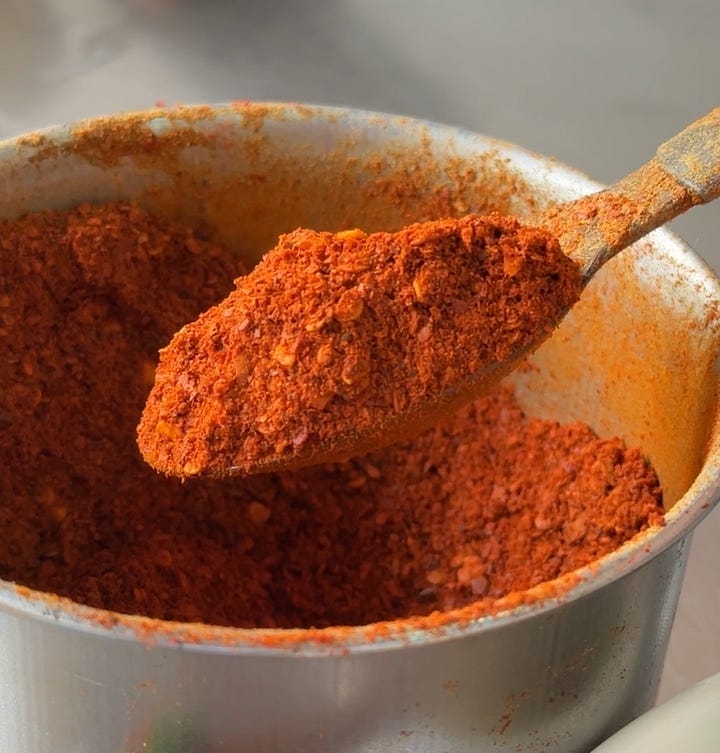

I have my suspicions that Kangjia may be using qiubei chili, a super-red chili from the neighboring Yunnan province (Steph disagrees, thinking that it must be some sort of local Bijie variant).
Either way, that absurdly red chili? It’s a dead ringer for… Korean Gochugaru, and hits a similar-ish spice level — this will be our workhorse in the following recipe.
That said, for us personally, Gochugaru isn’t quite spicy enough for our personal tastes. So we’ll use a mix of chili powders, cutting the Gochugaru with a spicy chili flake (a good cayenne pepper powder will be able to serve this function in the west).
Crispy Pork Noodles
Makes one serving. In the video, we made two servings — scaling up is certainly advised!
Slice
120g pork belly
into ~½ cm strips. Marinate with:
⅛ tsp salt
¾ tsp soy sauce
1 tbsp oil
Mix well. Then, add to a cool, dry wok (or pot) and up the flame to medium. Spread out the pork slices and render out the lard. Flip periodically. You do not need to nurse it, but to make sure to give it a stir every once in a while to make sure that things aren’t scorching or cooking unevenly. Once brown and crispy, strain into a bowl. Reserve the rendered lard, and return the crispy pork to a wok.
In a small bowl, mix
½ tsp honey
½ tbsp water
then add to the wok with the crispy pork and quickly blast the flame on high. It should only take ~10 seconds for the water to dissolve and the honey to stick to the pork. Remove and let sit on a paper towel lined plate.
Slice
1 sprig scallion
and set aside.
Mix together a seasoning sauce of:
⅛ tsp salt
¼ tsp MSG
¾ tsp Zhenjiang (“Chinkiang”) vinegar, -or- Balsamic vinegar1
1 tbsp soy sauce
1 tbsp water
and add to the bottom of your serving bowl.
Boil
80g dried wonton noodles
until done, strain well, and nestle on the seasoning sauce.
Sprinkle over the sliced scallion, together with
1 tbsp Gochugaru chili powder2
½ tbsp cayenne pepper powder (or a spicy chili flake/powder of your choice)
You can skip the cayenne pepper and use all 1.5 tbsp gochugaru if gochugaru is spicy enough for you.
Then, in a small pot, heat up
2 tbsp of the previously rendered lard
until smoking, or ~190C. Ladle the sizzling oil over the noodles, aiming for the chili powders. Top with the crispy pork, then mix well and devour.
In Bijie they will use a local vinegar called ‘qiaocu’ (荞醋), made from bitter buckwheat. It’s a bit more mild than either Shanxi Mature vinegar (陈醋) or Sichuan Baoning vinegar. We felt that Zhenjiang Vinegar (香醋) was an appropriate substitution.
For this specific dish, I think balsamic vinegar could also work well. Balsamic is a little sweeter and lighter than many Chinese aged vinegars, but would hit the same note in the context of this dish.
Kashmiri chili powder would also work well for this.

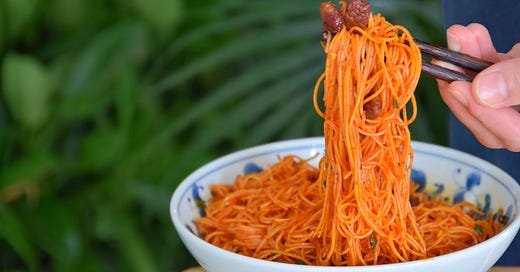





So in a lot of your recipes you talk a bit about which varieties of chilli pepper to use. Do you know any that use capsicum chinense? None of the recipes I find online use it, but with the name it had to be popular in china at some point, right?
Great recipe and write-up, I look forward to trying it. I was thinking kashmiri chilli might fit for colour.